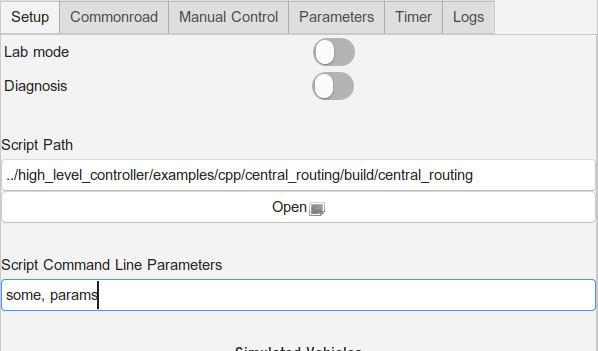Page History
This example is a guideline on how to write a Matlab script that, together with the Middleware, communicates with a vehicle. This tutorial is based on our platoon example (which is just a series of vehicles following a preset path without much logic behind that behavior), which you can find in
https://gitgithub.rwth-aachen.de/CPM/Project/Lab/software/-com/embedded-software-laboratory/cpm_lab/tree/master/high_level_controller/examples/matlab/platoon
More specifically, we well take a look at main_vehicle_ids.m.
...
| Info | ||
|---|---|---|
| ||
The init script is similar (in its idea) to the cpm library for your C++ programs: It is supposed to take care of redundant work for you. In this case, it sets up all relevant DDS participants for the communication within the network. It also loads the required IDL files, loads XML files for QoS settings and sets the variable for the stop signal, which will be mentioned later on. It currently requires a given folder structure, which is automatically set up on the NUCs and should also be part of the software repository's structure - in an ideal case, you do not need to worry about that, as long as you import the init script from its original place (TODO: although other rules may apply for deploying remotely). You can find it here: https://gitgithub.rwth-aachen.de/CPM/Project/Lab/software/-com/embedded-software-laboratory/cpm_lab/blob/master/high_level_controller/examples/matlab/init_script.m |
| Info | ||
|---|---|---|
| ||
Please consult RTI DDS and Matlab to get an idea of how to work with DDS in Matlab. The Middleware-specific IDL file is only relevant for the communication between Middleware and Matlab script and is thus not part of the cpm library. |
...
then you need to pass some, params as additional parameters in the LCC's UI (ignore the script path in the screenshot):
What your HLC scripts need to include
Import the init script
Set the Matlab domain ID to 1, go to the right directory for the init script, load the script, store the vehicle IDs. In this the case , for the reader that reads all vehicle states sent within the network , aggregated by the Middleware, a waitset is set to wait upon taking data from the reader if no data is yet available. The timeout is set to 10 seconds.
function main_vehicle_ids(varargin)
matlabDomainID = 1;
clc
script_directoy = fileparts([mfilename('fullpath') '.m']);
cd(script_directoy)
% Initialize data readers/writers...
init_script_path = fullfile('../', '/init_script.m');
assert(isfile(init_script_path), 'Missing file "%s".', init_script_path);
addpath(fileparts(init_script_path));
[matlabParticipant, stateReader, trajectoryWriter, systemTriggerReader, readyStatusWriter, trigger_stop] = init_script(matlabDomainID);
cd(script_directoy)
vehicle_ids = varargin;
%% wait for data if read() is used
stateReader.WaitSet = true;
stateReader.WaitSetTimeout = 10;
%% Do not display figures
set(0,'DefaultFigureVisible','off');
Tell the Middleware that your script is ready to operate
You must send a ReadySignal message after initialization - only the ID string matters, which must be of the form "hlc_" + vehicle_id, where the latter is the ID of the vehicle the HLC and thus your script is responsible for:
...
You use the ReadyStatus type here, which was defined in one of the IDL files that was imported for you using the init script. You can see the values of this type in the IDL file:
https://gitgithub.rwth-aachen.de/CPM/Project/Lab/software/-com/embedded-software-laboratory/cpm_lab/blob/master/cpm_lib/dds_idl/ReadyStatus.idl
This message tells the Middleware that your script is now ready to operate and to receive its data. Thus, at this point, your reader for vehicle states (here stateReader) should be initialized so that it can receive the data.
Consider the timing signals
This is very important. There are two signals you must consider: Start and stop signals. You have to check regularly for the stop signal, and once for the start signal:
...
if got_stop == false
while(true)
disp('Checking system trigger for stop signal');
trigger = SystemTrigger;
sampleCount = 0;
[trigger, status, sampleCount, sampleInfo] = systemTriggerReader.take(trigger);
break_while = false;
while sampleCount > 0
current_time = trigger.next_start().nanoseconds();
if current_time == trigger_stop
break_while = true;
end
[trigger, status, sampleCount, sampleInfo] = systemTriggerReader.take(trigger);
end
if break_while
disp("Stopping bc of stop signal");
break;
end
disp('Waiting for data');
...
Receive information about your vehicle
Information about your vehicle are contained in the VehicleStateList messages, which include the current states and observations of all vehicle as well as the current time. This signal is supposed to be the start signal for the HLC, so computation should start using this data directly after the message was received.
...
...
disp('Waiting for data');
sample = VehicleStateList;
status = 0;
stateSampleCount = 0;
sampleInfo = DDS.SampleInfo;
[sample, status, stateSampleCount, sampleInfo] = stateReader.take(sample); %Due to the set waitset, you wait for up to 10 seconds at this point, unless old data is available
% In this example, messages that were received during computation that should be ignored are not thrown away before waiting for new data
% If your script is faster than the period with which it is called, this is not problematic, in any other case you will probably end up using wrong timing and outdated vehicle data
% Check if any new message was received
if stateSampleCount > 0
disp('Current time:');
disp(sample.t_now);
...
Send commands to your vehicle
You need to send vehicle command messages as a result of your computation including the vehicle ID to the Middleware, which propagates these to the vehicle. The implementation of the computation of e.g. the vehicle's trajectory is not explained here and depends on your task. You are only given an example of how to send a simple trajectory here.
...
